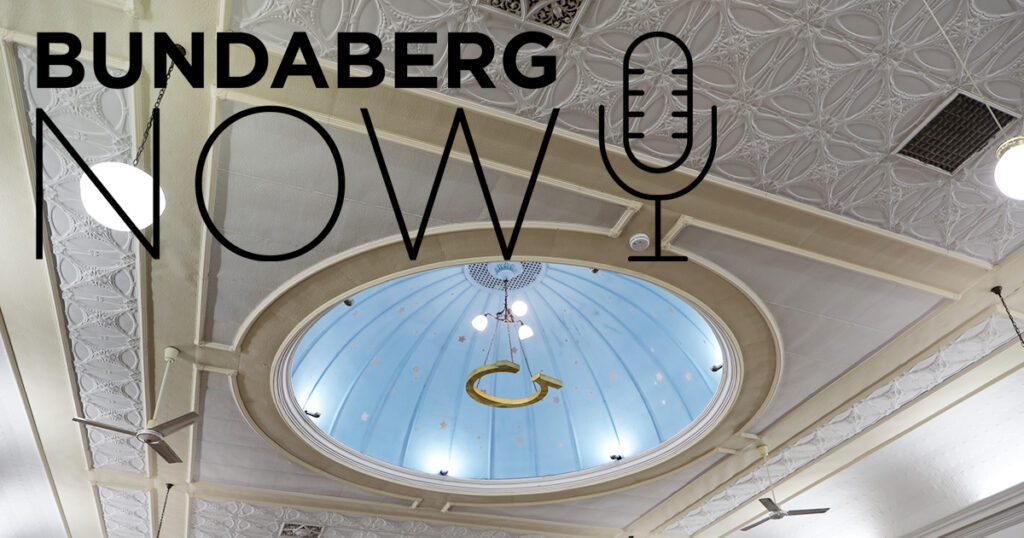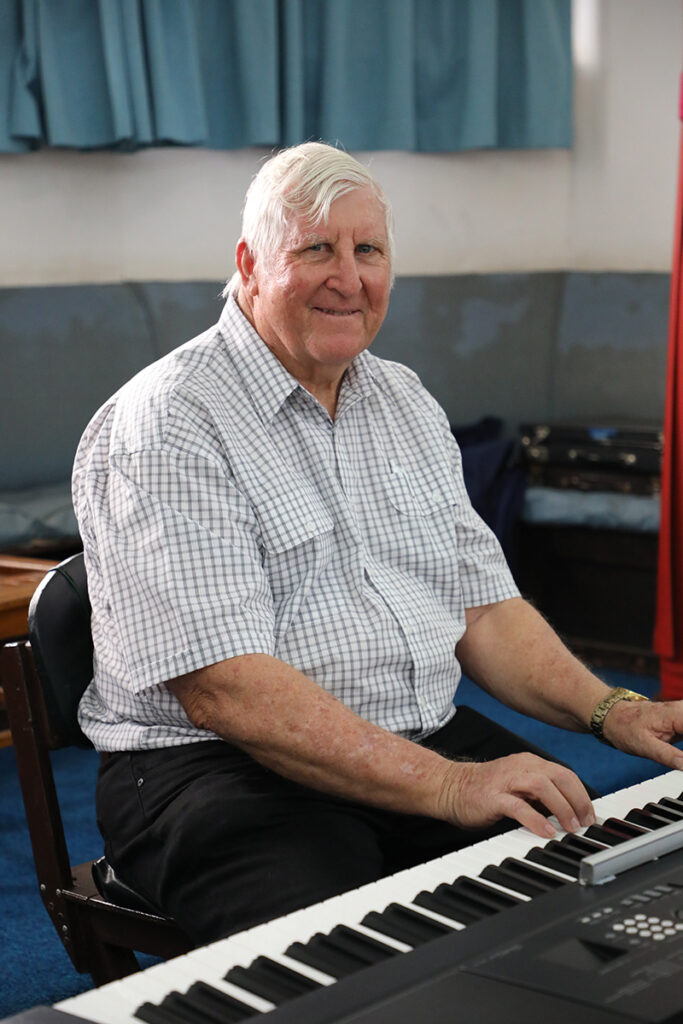
Welcome to Hidden Histories: Masonic Hall Bundaberg, the sixth episode of series two of the Bundaberg Now Podcast.
The local Freemasons have not only opened the doors to their Masonic Hall, but also shared some of their secrets, rituals and history.
Freemasons member Ian Clarke said while the group is no longer as shrouded in mystery as it once was, people will have to visit themselves to learn more.

“It’s not a secret society, it is society with secrets,” he said.
The building, at 61 Bourbong Street Bundaberg, has an unassuming façade, giving no hint to the rare Masonic Dome and pressed steel ceiling contained within.
“It’s to represent the sky. So, the moon, the stars and the sky. And that all forms part of our ritual work.
“It’s just really a wow factor, because from outside you don’t expect to see a building like this with the architecture and all the columns.
“Everything in Freemasonry is done on the square and the level, so of course, compasses and squares and plumb rules all form a very important, important part of our ritual work,” Ian said.
In this podcast episode, Ian takes us on an audio tour of the building, which contains the meeting room for the Order of the Eastern Star, as well as a supper room added to the building in the late 1970s.
Listen now to hear more about the Freemasons and the Masonic Hall:
In this series we shine a spotlight on the heritage buildings and infrastructure in our region.
Listen as we uncover memories, mysterious ghost stories and bizarre facts about some of our most iconic structures.
You can also listen on Google, Apple, Spotify, TuneIn or your favourite podcast app.
Subscribe to the podcast here.
Hidden Histories: Freemasons Bundaberg transcript
Gennavieve Lyons [00:00:05] Welcome to this special series of the Bundaberg Now podcast, where we shine a spotlight on the historic buildings of our region. My name is Gennavieve Lyons, and I’ll be your host as we uncover hidden histories, mysterious stories and some pretty bizarre facts about our most iconic buildings and structures. This month, we’re learning all about the Freemasons and their Masonic Lodge on Borboung Street. With a rich history, this building changed significantly after the Freemasons were donated it in the 1920s. Before that, it was originally a grocery store. Now fast forward to today, and the Freemasons are leaving all their secret men’s business behind them and opening their doors to the community, sharing elements of their ceremonies and explaining the meaning behind the only Masonic Dome in Australia. In this episode, Adele Bennett from Bundaberg Now sat down with Ian Clarke, who’s been a part of the Freemasons for decades.
Adele Bennett [00:01:03] So thanks so much for joining us on the Bundaberg Now podcast, Ian. Can you tell me a little bit about the history of the Freemasons in this building?
Ian Clarke [00:01:11] This building was donated by the Buss family, which was predominately a men’s menswear store back in the mid ’20s. Previously to this, it was a grocery store owned by Heathwood’s, and then the Buss family bought it and donated it. And the top floor where we are now was the living quarters back in those days and then it got rebuilt as a Masonic Temple. But it’s just a magnificent building with its columns and architecture and the steel roof and the dome, which is predominately one of the only domes like this in Queensland.
Adele Bennett [00:01:51] And can you tell me about what that represents?
Ian Clarke [00:01:54] It’s the heavens. And because Freemasonry was around before the New Testament, we work off the Old Testament. So up, up in the roof. When we get there, the G stands for God or grand, like the grand geometrician of the Universe.
Adele Bennett [00:02:16] Great. And there’s some stars and the sky blue?
Ian Clarke [00:02:20] It’s to represent the sky. So, the Moon, the stars and the sky. And that all forms part of our ritual work. The ceiling is all pressed steel, which was a marvelous building material back in, back in the ’20s. It’s not used these days because there’s too much chip rock or fibrous plaster of whatever. But to have a high ceiling like this is just something to behold.
Adele Bennett [00:02:48] And this is the only sort of ceiling and dome of its kind in Australia?
Ian Clarke [00:02:53] It’s the only dome. I wouldn’t say the ceiling, I’d say there’d be still a few pressed steel ceilings round, but the dome in Freemason’s buildings, this is really unique.
Adele Bennett [00:03:01] Yeah, great. Is there any reason why that we know of that, that they chose to include that in the renovation?
Ian Clarke [00:03:07] Only that any that it represents the Sun, the Moon and the stars and so on. Back in the ’20s they must have had great foresight to build something like that, to build a dome like that because most other lodges just have a flat ceiling, and the G is suspended by a cord out of the ceiling.
Adele Bennett [00:03:30] So what is people’s first impressions when they walk in here? If they’ve never been in?
Ian Clarke [00:03:35] It’s just really a wow factor, because from outside you don’t expect to see a building like this with the architecture and all the columns. And again, I can only say thank you to the Buss family for donating this building and all of its architecture. And they were great Freemasons, of course. But and as we go around later on, the columns are all made out of one piece of timber, the Doric, the Corinthian, and that they’re all made of one piece of timber.
Adele Bennett [00:04:11] So as you come up the stairs, what do you get to first and what does each room do?
Ian Clarke [00:04:16] When we come up the stairs the first room is the Order of the Eastern Star room, and that’s predominantly ladies. Although men can join the Order of the Eastern Star vs. women cannot join Freemasonry. So, and then from there, when we turn around, that’s top of the stairs. We come along the hall, that’s just a hallway with all the photographs of all past Masters from 120-130 years ago. And then we come into this, our main building.
Adele Bennett [00:04:51] You told me a little bit about the geometry and the mathematics of this room like in that how that all links to the Freemasons itself.
Ian Clarke [00:05:01] Yeah. Everything in Freemasonry is done on the square and the level, so of course, compasses and squares and plumb rules all form a very important, important part of our ritual work.
Adele Bennett [00:05:22] So things like the checkerboard sort of floor?
Ian Clarke [00:05:26] Tessellated pavement.
Adele Bennett [00:05:28] Tessellated pavement! What does that represent?
Ian Clarke [00:05:31] It’s a pavement where we don’t generally perambulate around that if we’re perambulating in any of our ritual work, we perambulate around the outside of the tessellated pavement.
Adele Bennett [00:05:42] OK, cool. And so, for people that don’t know much about the history of the Freemasons themselves, where has that come from? What was their role?
Ian Clarke [00:05:52] The Freemasons were true stonemasons. Today, we’re predominantly we’re non practicing stonemasons, whereas back in early days, the stone masons did all the finishing work on King Solomon’s Temple. So, King Solomon is another part of our ritual work.
Adele Bennett [00:06:15] And there’s different sort of levels isn’t there, and you sort of move around this room as you progress through the hierarchy? Could you tell me a little bit about that?
Ian Clarke [00:06:24] Yeah, we start off little area there, which is called the Inner Guard. We also have a Tyler who keeps guard on outside the door then we go to the Inner Guard. From the Inner Guard, we go to a Junior Deacon, from Junior Deacon to a Senior Deacon to a Junior Warden to a Senior Warden. And from then you become Master of the Lodge. So, so that’s how many years it would take you to get from bottom to top.
Adele Bennett [00:06:56] And so what does the Master do? Is that sort of like the chairman?
Ian Clarke [00:07:00] Yep, yep. The Master is exactly the same as a president or the chairman, and his wardens are senior and junior vice presidents. And our meetings just consist of, if we don’t have any ritual work, our meeting consists of the same as a soccer club or anything else. We read the minutes from the previous meeting. We do a treasures report. We have a general business and then we have correspondence in and out. So, yeah, so it’s identical in its workings on a normal meeting night as far as your local footy club.
Adele Bennett [00:07:36] So I guess that does lead me to the Freemasons have a bit of a reputation throughout the past of being secretive and men’s business. So, what is the difference now and what are you guys trying to do?
Ian Clarke [00:07:48] Yeah, sadly, sadly, many years ago. But after Second World War, when the men were all overseas and when they came back from there, that’s when Freemasonry had its greatest flourish because the men were looking for companionship. And that’s when it all happened. It’s not a secret society, it is society with secrets. But in this day and age with Google and everything else that goes with it, you can look up virtually everything. But these days, our lodges are a lot more family orientated. Our wives get into it, and we try and have social days every second month and we invite our wives and kids and everything there. So, it is more family orientated these days.
Adele Bennett [00:08:33] Right. And what is the role of the Freemasons in the community with charities?
Ian Clarke [00:08:38] We that’s right. Charity, charity, charity, charity. We’ve got some money tucked aside now in our lodge for the Bush Kids. United Green Lodge of Queensland, which is our head body, head organisations, every year, like I think last year, they gave $400,000 to domestic violence, to the Men’s Shed, to VMR in Hervey Bay to build that new volunteer marine rescue. So, so it’s all about charity and giving.
Adele Bennett [00:09:17] So back to our tour of the building. Once you’ve come through this amazing central room, then we head out the back, what’s out there?
Ian Clarke [00:09:24] That’s our supper room out there. And every year, as our members progressed through the chairs and reach the Master’s chair, we have a change over dinner, which is everyone’s invited family, friends, wives, kids, everything. So, out the back is just really a change over dinner. You know, that was about 1978 that was built because originally, before we had too many women in our organisations, we used to meet in a little tiny supper room up the front, which is now the lift. And it used to be the supper room, that’s how big it was. And then we started inviting women and where the OES is, which we’ll say sooner or later with the OES is now, that used to be our supper room. And then the OES decided that sell over and Peterson Street where they were, and they come in and come up here. And then we built the supper room out the back, which is used for anyone and everyone. And if anyone wants to rent it out, they can rent it out. There used to be a church group that met here, and they would use the supper room as a meeting place for the church.
Adele Bennett [00:10:37] So how about you? How long have you been involved with the Freemasons?
Ian Clarke [00:10:41] About 48 years.
Adele Bennett [00:10:42] Yeah. And what drew you to it and why have you stayed so long?
Ian Clarke [00:10:48] What drew me? I was working for Main Roads at the day, and there was a lot of Freemasons in Main Roads back in those days, and its sort of a different organisations because, I’ll just do it quickly, I was also in Rotary. In Rotary you can go along to the meetings all the time and see what it’s all about. And then you get asked to join and away you go. With Freemasonry, you’re really coming in a bit blind although these days we show off our building like we’ve never done before. But you don’t get to see anything until you come in on the first night and do your first degree. Now in just the Blue Lodge, it’s called the three degrees first, second and third, which is Entered Apprentice, Fellowcraft and Master Mason. And that’s what a lot of a lot of their members, they’re quite happy with that. But there are other degrees, theirs 18th, 30nd, 33rd, Royal Arch. There’s a whole range of other orders, if you’re that way inclined.
Adele Bennett [00:11:49] And so why are we stuck with it so long? What is it about it that you love?
Ian Clarke [00:11:56] The friendship. Everything we do has got to be memorised. Back in my early days, should I say this? Yes. I used to stutter, something terrible. And having to get up on the top up there and talk to them. It got me. I overcome that stuttering to a point where I very seldom stutter anymore. So, it’s just been great. My stepfather was a member here, my father in law, so it’s all sort of part of the family. And I just enjoy the fellowship and more so these days, but I invite my wife to our functions and my wife’s very much involved in the ladies side of things. We have functions that the ladies run. And so we’re very family orientated these days, more so than years ago.
Adele Bennett [00:12:42] Yeah, great. And what is your role in the ceremonies?
Ian Clarke [00:12:47] I fill in any way I’m needed to fill in because I’ve done every office I’ve done. But my main role these days is the organist, so I play for, we have opening odes. We have God Save the Queen. We have Advance Australia Fair and then we just have casual music for any perambulations or if there’s a bit of a lull anyway, I just harmonize. And that’s what I do in the Lodge.
Adele Bennett [00:13:13] Well, thank you so much for having a chat. It’s been great to find out all about it.
Gennavieve Lyons [00:13:17] What a fascinating insight into Freemasonry and the beautiful Masonic building. Keep an eye out for it next time you’re strolling through the Bundaberg CBD. Thanks for listening to the Bundaberg Now Hidden Histories podcast. Tune in again next month, where we’ll hear about another of our region’s iconic buildings and structures.




